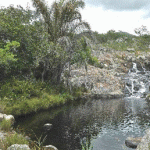TREE LIFE
March 2015
MASHONALAND CALENDAR
Saturday March 7th (NOTE CHANGE OF DAY AND TIME): Botanic Gardens Walk with Tom Muller: Meet at 9.00am in the car park of the Harare Botanic Gardens. This walk will last for 1hr 30mins.
Sunday 15th March – Meg’s Birthday lunch ($20 per person, deadline for payment to CABS 8th March). Tree walk in the Gardens before lunch, meet at the restaurant at 10.00 am.
Saturday 28th March – Visit to the vlei area at the University of Zimbabwe.
BIRTHDAY LUNCH FOR MEG COATES PALGRAVE
Meg Coates Palgrave has been involved with the Tree Society for over 30 years. She reaches her 80th birthday in March this year and the Society is going to celebrate this achievement with a lunch to which you are all invited. The date of the lunch will be Sunday March 15th and the venue will be the restaurant in the National Botanic Garden. The cost of the lunch (including wine) is US$20 per person, to be paid into the Tree Society CABS account (100-254-9477 account name W.R. Clarke a/c Tree Society) no later than 8th March 2015.
Please make sure your name is reflected as a reference, and also advise the Treasurer (wrc@mweb.co.zw) by email of the date of your deposit.
Meg has made an enormous contribution to our knowledge of trees and has been a part of our lives for so long. It is hoped that all Tree Society members will try to attend the lunch.
The timetable for the day will be;
10.00 – 10:30 am: assemble at the Botanic Gardens Restaurant
10.30 – 11.45 am: Walk in the garden, led by Meg
12:00 noon: speeches and presentation to Meg
12:45 pm: Lunch
There are no events organised for the afternoon.
People should bring all other drinks apart from wine and any glasses they may need.
TREE OF THE MONTH
Commiphora africana
Family: – Burseracea (the myrrh family)
Common names: Poison-grub corkwood; Nd: Iminyela; Sh: Mubvuka.
Etymology: The genus name Commiphora is from the Greek “kommi”, meaning “gum”, and “phoros”, meaning “carrier”. The bark of most species peels off in papery pieces and flakes, often with a greenish layer underneath. Mostly the bark is corky but some species have variable bark. Commiphora are dioecious, i.e. there are separate male and female trees.
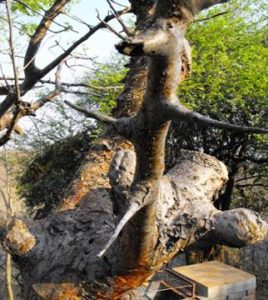
Commiphora africana, the young branches are very spinescent.
All Commiphora exude a resin that can be fragrant or have medicinal properties. The most famous being Commiphora myrrha, originating in desert areas in the horn of Africa and producing the biblical myrrh.
In Zimbabwe the Commiphora are well represented, particularly in the drier areas, for example: C. africana, C. angolensis, C. caerulea, C. edulis, C. glandulosa, C. karibensis C. mossambicensis, C. marlothii, C. mollis , C. pyracanthoides, C. shimperi and C. viminea. Interestingly several dwarf species such as C. kraeuseliana, C. saxicola and C. virgata grow in the semi-desert areas of Namibia.
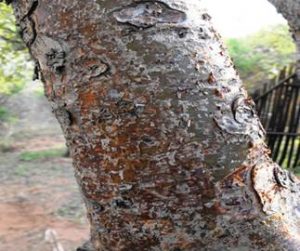
bark of Commiphora africana
Of all the Commiphora C. africana has the widest geographical distribution, from Western Namibia to Eastern Mozambique, Botswana and Northern South-Africa.
The bark is yellowish-grey to green, it flakes in little round yellow flakes, and the young branches are very spinescent.
The leaves are trifoliolate; the leaflets obovate or broadly elliptic, the terminal leaflet is about 1 cm long by 1/2 cm wide; the two lateral leaflets are much smaller – about 1/3 of the end one. The leaflets are coarsely toothed and velvety.
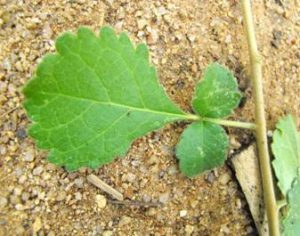
Commiphora africana leaves
The flowers are greenish pink, small and inconspicuous, opening in October. The petals are up to 5 mm long, in tight, auxiliary clusters. The fruit is almost spherical, about 1 – 2 cm in diameter, pinkish red; stone partly covered by a red, fleshy pseudo-aril (from November to March).
The tree has many usages, for instance the roots of young plants are juicy with a mildly sweet taste and can be chewed. The gum is also eaten and the bark can be brewed to make a red tea. The leaves are browsed by livestock. The wood can be used for house building, headrests, stools, milk containers and wooden spoons as well as poles for live fences. In some areas the stems are utilised as toothbrushes. On the medicinal side the fruits are chewed or pounded and used against toothache and diseases of the gum. Gum extracted from the stem is used in making arrows. The larva of the beetle Diamphidia, from which the San make their arrow poison, feeds exclusively on these trees.
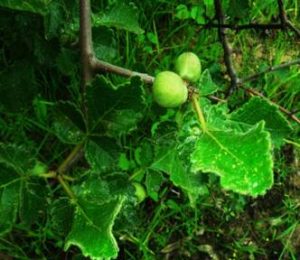
fruit of Commiphora africana
Sources:
Coates Palgrave, K. 1977. Trees of Southern Africa . Struik, Cape Town.
Gelfand, M. et.al. 1985. The Traditional Medical Practitioner in ZImbabwe. Mambo Press, Harare.
Goldsmith, B. and Carter, D.T. 1992. The Indigenous Timbers of Zimbabwe. Forestry Commission, Harare.
Joffe, P. and Olberholzer, T. 2012. Creative Gardening with Indigenous Plants: A South African Guide. Briza, Pretoria.
Van Wyk, B. and Van Wyk, P. 1997. Field Guide to the Trees of Southern Africa . Struik, Cape Town.
Photographs: JP Felu.
– J.P. Felu
CATAPÚ –TREE SOCIETY VISIT April 25 to May 2 and/or May 2 to May 9 2015
This is to remind and reassure everyone that the planned visit to Catapu is still on!! I very much hope that in doing it this way there won’t be bookings for half of one and half of the other!
Catapu is a magical place and a tree lover’s paradise, I have recorded over 260 tree species. There are short walks leading from the camp through the natural forest and the trees on the paths have been numbered. A list of numbers with the names will be provided so it is brilliant for trees but also good for birds, butterflies and wild life. The wildlife of the area includes Suni, Red Duiker and Nyala, also Samango monkeys and the Crested Guinea Fowl are often seen. This has become a renowned birding site and features as 197 on the Sasol’s 200 top birding sites in southern Africa. So there is lots of interest . This year they have had exceptional rains and all the pans are full. I, for one, am looking forward to seeing them. That also means the vegetation will be amazing.
In addition it is an easy drive to a number of places of interest including the Inhamatanga forest reserve and adjacent Coutadas (hunting concessions) about 30 kms away, Mary Moffat’s grave (wife of David Livingstone) at Chupanga Mission (60 kms), the new bridge over the Zambezi River (35 kms), and the Sena Bridge, the longest single-span metal rail bridge in the southern hemisphere (3,700 ms).
Catapú is 700 km from Harare and the road is tarred all the way. Mpingwe Camp where we will be staying is situated 32km south of the Zambezi River on the main north/south highway (EN1). The EN1, the road from Inchope to Catapú still has many potholes, and that does slow things down a bit. I used to do it from Harare comfortably in a day and with an early start and a sturdy vehicle I am sure that is still possible. For visits to some of the places around the area, a sturdier vehicle than a sedan will be desirable and I hope that some people will be coming in such vehicles and will be prepared to share transport.
Accommodation is provided in comfortable log cabins and will cost about $20-25 per person per night. There are two slightly more luxurious cabins, 21 and 23, each with two, three-quarter beds, en suite bathrooms and separate seating areas which cost $60 per night.
There is a restaurant with drinks and meals available. Meals will probably cost up to about another $20-25 a day depending on whether you have steak or spaghetti. Coke and beers are $2—3 each, wine and spirits are also available.
Camping and self catering are not permitted in accordance with Mozambique law.
Fuel is about 50 MT per l and there are now fuel outlets at various places along the way. Availability is a bit variable but during a week it should be available in Caia. For those who don’t have SADC country’s passports (i.e. Zimbabwe or South Africa) a visa will cost about US$ 85. For those taking their own cars, car insurance costs R150 or about $US25. The present rate of exchange about 30 MT to $1 (to be confirmed)
I look forward to hearing from you: megcp@zol.co.zw; (04) 886134 or 0772234433 and please make a deposit of $100 into the CABS account number: 1002549477, Account name: W .R. Clarke Tree Society and please make sure your name is reflected as a reference, and also advise the Treasurer (wrc@mweb.co.zw) by email of the date of your deposit.
– Meg Coates Palgrave
VISIT TO CHIMANIMANI Thursday, 29 January to Monday 2 February 2015
Day 1: 29 January 2015
This was probably the best-attended Tree Society outing ever, with 46 people arriving in Chimanimani for 3 days of treeing and socializing in convivial company. In my period of membership (from about 1988) I think the largest number we ever had in the past was 32 people who came to Nyanga in 2002. There is no doubt that these longer trips are very popular.
It was also 14 years since the previous Tree Society outing to Chimanimani. On that occasion, written up in Tree Life 257 (July, 2001) and available online at: http//:www.lind.org.zw/treesociety/newsjul01.htm the trip was from 13 – 18th April 2001. Interestingly two of the places visited on that trip were the same as on this one, namely Outward Bound and Rathmore Forest.
Very detailed preparations had been made for the weekend by Bill Clarke, who had made a special trip to Chimanimani in 2014 to inspect the accommodation, visit the various possible venues and arrange activities for each day. Meg Coates Palgrave assembled a list of trees from the area and this was available for participants to use. Most people came from Harare but a few came from further afield.
The Thursday was mostly spent travelling. Meg and I traveled together (we were to have taken Tom Muller but sadly he was not well enough to come). The Harare to Mutare road is these days in excellent condition and the stage from Mutare to Chimanimani also pretty good so we made good time, stopping for a picnic lunch at the Umvumvumvu River Bridge. Here we made a respectable list of trees at this low altitude venue (870 m).
On arrival we went to the Farmhouse where we were greeted by Bill and Fiona and given firstly the traditional glass of sherry and then our ‘pack’ for the weekend with details of our accommodation. We then had time for a quick visit to our “cottage”, which turned out to be a very substantial and spacious place indeed.
At 5 pm, our convoy then headed out along the Cashel Scenic Road to a spot giving a marvellous view along the line of the Chimanimani Mountains. Doug van der Ruit was our guide and he pointed out features of interest along the mountain range.
Then back for the first of our regular evening dinners at the Chimanimani Hotel, including notices from Bill, a welcome speech from your Chairman and a talk on the mountains by Doug.
– Mark Hyde
DAY 2. 30 JANUARY 2015: OUTWARD BOUND SCHOOL
Forty-six members and guests of the Tree Society gathered at The Farmhouse on the outskirts of Chimanimani village after breakfast and drove in convoy to the Outward Bound School at the foot of the rugged Chimanimani Mountains. Once there we were allocated to two groups. One group accompanied Mark Hyde to Tessa’s Pool, close to the school on the upper reaches of the Haroni River. Dagmar and I followed Meg Coates-Palgrave and Dave Meikle, director of the school, in the other direction.
After about an hour’s ambling at normal Tree Society speed (15 trees per hour) we reached a junction in the path. We should have turned left there for a 10 minute walk home for our scheduled tea break at the school, but were persuaded that the other route, along the Hadange River, would be much more interesting and would only take 20-25 minutes longer. Two hours later we finally made base, to find the other party busy with lunch. The diversion entailed negotiating a narrow path on a very steep slope and clambering over several stiles and up onto a rocky ridge, but botanically and scenically it was worth the effort.
We started in the school grounds, where we noticed two alien invaders that are very common in the Eastern Districts growing amongst the ornamental shrubs. One was Vernonanthura phosphorica, a native of Brazil, which was apparently introduced as a nectar plant for bees in Mozambique in the 1990s and is now a widespread invader in the Eastern Highlands. Superficially it resembles a Vernonia, with which we are all familiar, and can reach 4 m in height.
Once out of the grounds we entered indigenous woodland that soon changed to evergreen forest, from which we emerged again into woodland on the slopes above the Hadange River. Some of the larger trees were species we know from around Harare, notably Uapaca kirkiana (Muzhanje), which was very common on the rocky slopes.
Of more interest were those that are special to the Eastern Districts. Brachystegia utilis (False Mufuti) was widespread and had us puzzled to begin with. It is a typical Brachystegia, but with 6-10 pairs of leaflets, which puts it in between B. boehmii and B. glaucescens, which have more leaflets, and B. spiciformis, which has less. It has a distribution limited to the eastern border of Zimbabwe and further North.
Albizia adianthifolia, Rough-bark flat-crown, with feathery, bipinnate leaves, was also present. It too has a limited distribution at lower altitudes along the eastern border (Outward Bound is just over 1100m high), being replaced at higher altitudes by the very similar A. gummifera and A. schimperiana.
Newtonia buchananii, Forest Newtonia, is another species with feathery leaves that is restricted to the Eastern Highlands. The diagnostic feature of the genus is the presence of small stalked glands along the rachis between each pair of pinnae.
Breonadia salicina (Breonadia) is also confined to the eastern border in Zimbabwe, although it does extend further South. It has long, narrow leaves as the name suggests, from salix, meaning willow, and closely resembles Rauvolfia caffra, which we often see around Harare, but can be readily differentiated from it by the absence of milky latex. Heteropyxis dehniae, Lavender tree, growing on the slope above the Hadange River, surprised us as being a large tree, with peeling, distinctly pink bark, much larger than we are used to around Harare. It gets its name from the distinctive, pleasant aroma of the leaves when they are crushed.
In the understory of the evergreen forest the dominant species were Harungana madagascariensis, Maesa lanceolata, Bridelia micrantha and Englerophytum magalismontanum. Harungana madagascariensis, commonly called Orange blood, on account of the orange latex in the leaves, or Praying hands, because of the characteristic clasping together of the large, terminal pair of leaves, is an Eastern Districts special.
The Maesa (Maesa), Bridelia (Mitzeerie) and Englerophytum (Stemfruit) occur around Harare as well, but are not usually as common and as lush as they were in the forest. The presence of colonies of Dodonea viscosa, Sand olive, was a surprise in that environment. A trifoliate Searsia in fruit that we assumed was S. longipes, with which we are very familiar, turned out to be S. chirindensis, which does not occur near Harare, the diagnostic difference being the very long petioles.
A feature of the forest was the abundance of creepers covering the understory. The first to catch our attention, and our ankles with its tough, prickly, trailing stems, was Smilax anceps (Smilax). The leaves are very broad, with several pairs of veins arising on either side of the midrib from the base of the leaf. Dioscorea schimperiana was also widespread. It has leaves very similar to Smilax, but larger, and is not so unfriendly. A Landolphia species, Apricot vine, one of two very similar species that are difficult to differentiate when not in flower, was less common but was notable in that it was bearing large, spherical fruit. Cassytha pondoense was an interesting find, appearing to be merely a bundle of leafless green string but in actuality a parasitic plant, though what it was parasitizing we didn’t establish.
Finally, a few of the plants that excited Meg were a Cyperus (Sedge), not identified specifically, growing in the bottom of a dry stream bed; a slender orchid with minute flowers growing on a tree above the Hadange River, Microcoelia exilis; and a leguminous plant with leaves arranged in overlapping layers like a louvre window and huge stipules, appropriately named Aeschynomene grandistipulata, which is restricted to the Chimanimanis.
It was a fascinating, though somewhat tiring walk, and we are most grateful to Meg for showing us the unusual flora of the Chimanimani foothills.
– John Lawrence
DAY 3. 31 JANUARY 2015: BRIDAL VEIL FALLS
The morning began with a hectic Scavenger Hunt in which the group was split into six teams and given a list of 20 tree species to find. The Hunt had been prepared by Doug. After the Hunt had been adjudicated (the Leopards were the winners), the group again split into two with Mark and Meg leading each of the groups. We were part of the group led by Mark, which went along the river close to the Falls themselves. Here is a list of the plants we identified:
Celtis africana, family Ulmaceae, Common name: Celtis. This tree has a wide distribution from the coast to evergreen forests and can be confused with Trema orientalis, also Ulmaceae, the Pigeonwood. Celtis can be a fine spreading tree with pale trunk and branches, conspicuously leafless in winter. The leaves are ovate, hairy and three veined from the base. A good tip from Mark to distinguish between Celtis and Pigeonwood was that Celtis leaves are serrated over the upper two-thirds only, whereas Pigeonwood leaves are finely and regularly serrated along the entire length. The next day we saw magnificent Pigeonwoods in the Rathmore forest competing in height with the Albizia.
Erythroxylum emarginatum, family Erythroxylaceae, Coco tree. Ours was a straggling shrub but the species can be up to 9 m in height and may be found in ravines, evergreen forests, rocky outcrops and coastal bush. The stem is slightly flattened and the species has oblanceolate leaves up to 5 cm long, which are dark green, stiff textured, with prominent veining and the apex slightly notched. The leaves can be folded close to the ear and a crackle can be heard. There are sweet scented flowers 10 mm in diameter, which can be seen from September to December.
Ilex mitis, family Aquifoliaceae, the Holly family. This tree is often found on stream banks in evergreen forest leaning over water. The bark is pale and smooth, the leaves are narrowly elliptic, simple, alternate, shiny dark green and purple-tinged in new growth. The mid-vein is deeply channeled with the apex sharply pointed. The flowers are white, sweetly scented with the sexes separate on different trees. Fruits are edible, spherical and crimson from April to July, hence the common name, African Holly.
Choristylis rhamnoides, family Iteaceae, False shiny-leaf. This is a shrub or scrambler with long trailing branches, or a small tree to 3 m. It is found in high altitude forest. The leaves are alternate, elliptic, shiny, light green with veins pinched below. The leaf margin is serrate with the teeth glandular and the petiole is reddish when young. It bears greenish-yellow flowers from August, so fruit and flowers were absent at this time.
Ensete ventricosum, family Strelitziaceae, Wild banana. A fleshy tree up to 12 m with fleshy leaves, found in high rainfall forest along streams. The stem consists of old leaf bases and the leaves are spirally arranged and may be up to 5 m in length. The flowers are large spikes up to 3 m long, covered in a maroon spathe bract. This does not make soft, banana-like fruits but a mass of seed.
Acacia abyssinica, family Fabaceae (Mimosoideae), Nyanga flat-top. This conspicuously flat-topped tree, up to 15 m in height, seems to always be in groups at high altitude in mountain gullies. Leaves can have up to 51 pairs of pinnae, each bearing many small leaflets.
Dombeya burgessiae, family Sterculiaceae, Pink Dombeya. A tall shrub with large ovate, 3-lobed, leaves which are about 10-12 cm in diameter and are sparsely hairy on both surfaces with a scalloped margin. This is commonly cultivated.
Trimeria grandifolia, family Salicaceae (formerly it was in Flacourtiaceae), Mulberry leaf Trimeria. This is so like a mulberry leaf that it made it easy to find at the Scavenger Hunt. A medium sized tree up to 10 m in height forming the understory of evergreen forest. Leaves, large, ovate to circular, 5-9-veined from the base, shiny dark green when mature with the apex rounded or notched and the margin toothed. Flowers small, greenish.
Ficus craterostoma, family Moraceae, Rare forest fig. Our scavenger hunt team was fortunate to have Bilal who found this fig as it is most unusual. It is a small to medium tree, 12 m in height, found in heavily wooded mountain ravines where it can be a strangler. The tree has smooth grey bark and the leaves have a characteristic shape, i.e. narrow triangular and the apex with a “squared off” or truncate end. The leaves are about 7 × 3 cm, leathery and without hairs; the base is tapering and the margin entire. The figs, which were present, are small, 10 mm, not hairy and in the axils of the leaves.
Clausena anisata, family Rutaceae, Horse wood. A small tree to 5 m in height occurring in the forest fringe along rivers, found from sea level to 2,200 m. The bark is smoothish grey/brown. The leaves are alternate, compound, with 10-17 alternate to sub-opposite leaflets including a terminal leaflet; the leaflets are ovate to narrowly elliptic, purplish when young and they are covered in glands (dots) and have a strong aniseed smell when crushed. The flowers are yellow-white in sprays and the fruit is spherical, 7 mm diameter and black when mature.
Solanecio mannii, family Compositae, Canary creeper tree. This species is a much-branched shrub up to 7 m in height, occurring at high altitudes at margins of evergreen forest. The bark is green to grey and the branches are marked with conspicuous leaf scars. The leaves are crowded at the ends of branches, simple, oblong-elliptic, up to 40 × 12 cm, light green, velvety, with apex and base tapering. The leaf margins are jagged and the petiole is broad-based, up to 2 cm long. The plant has yellow, daisy-like flowers, which have an unpleasant smell in the evening.
Rapanea melanophloeos, family Myrsinaceae, Cape beech. Rapanea is a small to medium tree up to 10 m in height, found in evergreen forest. The bark is light grey, smooth to flaking and the stem is fluted in mature trees, while young branches can be square. The leaves are clustered at the ends of branches, oblong-lanceolate, 5 to 13 × 0.8-5 cm, leathery, dull dark green above and paler beneath. Translucent gland dots and streaks may be seen when the leaf is held up to light. The petiole is up to 1.5 cm long and is typically red and grooved. The flowers are white and inconspicuous. The fruit are spherical, up to 5 mm in diameter, and are clustered on the branchlets, green, becoming white and purple when ripe.
Rhoicissus tomentosa, family Vitaceae, Forest grape or Simple-leaved grape. This plant clambers over trees and bushes associated with forest. The branches are covered in brown hairs. The leaves are simple, large, almost circular, up to 20 cm long and are conspicuously 3-veined from the base; the upper surface is green and the under surface has rusty soft hairs. Flowers were not present but fruit which are spherical, 2 cm in diameter and purple black when mature, were seen. This was another easy find at The Scavenger Hunt as it is so grape-like in appearance.
Hypericum revolutum, family Clusiaceae, Curry bush. This is was the first of two species of Hypericum seen on this day. It is a shrub, but may reach 3 m in height. It is found at high altitudes, in grassland, along streams and at forest margins. The leaves are small and narrow, 2 × 0.5 cm, in opposite pairs, crowded along the stems, fresh green to bluish with no petiole and the margin entire. Flowers are solitary, about 5 cm wide and bright yellow, and seem to appear throughout the year. The fruit is a brown capsule. This is a good garden subject, although it gives off a curry smell.
Hypericum roeperianum, family Clusiaceae, Large-leaved St John’s Wort. A shrub occurring at high altitudes, in mountain grassland and along stream banks. It resembles the Curry bush but has much larger leaves which are more widely spread along the stems.
Halleria lucida family Stilbaceae (formerly Scrophulariaceae), Tree Fuchsia. We saw this to the side of the falls with trailing branches. This is an attractive tree to a variety of birds especially the sunbirds.
Leucosidea sericea, family Rosaceae, Leucosidea. This species is a grey straggling shrub of high altitudes along kloofs. The bark is reddish and flaking in strips and the young branches have persistent stipules. Leaves are alternate, compound, with up to three pairs of leaflets and a terminal leaflet. The leaflet margins are jaggedly toothed. The flowers are small, greenish and clustered in sprays.
Diospyros whyteana, family Ebenaceae, Bladder-nut. A small tree or shrub of mountain slopes, forests and rocky places. Bark smooth almost black. Leaves with the petiole nearly absent, glossy above, paler beneath, held alternately in two ranks, elliptic to ovate-oblong 4 × 2 cm with the margin entire but hairy. Flowers cream to pale yellow, fragrant, 5 to 10 cm long. Fruit, distinctive, spherical, 2 cm long, red when mature, bladder-like, loosely holding the seeds which germinate readily; a good garden shrub.
Streptocarpus michelmorei, family Gesneriaceae. Growing along the damp bank as we turned from the falls down the slope, this was flowering among ferns. The flowers were tubular, mauve to blue, with yellow streaks inside The single leaf was oblong, with veins raised on the upper surface.
Teclea nobilis, family Rutaceae, Small-fruited Teclea. One of the largest species of the genus, this is an evergreen shrub or tree up to 13 m in height. It is found in riverine evergreen forest. The leaves are 3-foliolate with the leaflets narrowly elliptic, 12 × 3 cm, dark glossy green, apex tapering, attenuate, base tapering, margin entire. Translucent gland dots are present and crushed leaves have a pleasant smell. The flowers are small, yellow to cream and scented. Fruiting trees are conspicuous, bearing red/orange fruits when ripe, in large heads.
Catha edulis, family Celastraceae, Bushman’s tea. A shrub or small tree, occurring in medium to high altitude evergreen forest, or on wooded hillsides. Bark grey, becoming dark and rough in large trees. Leaves elliptic or oblong, pendulous, glossy-green above, paler beneath, leathery, tapering to the base and apex; margin toothed; petiole 10 mm long. Flowers pale yellow. Fruit a 3-lobed capsule, splitting to release winged seeds. This tree can resemble a Eucalyptus. It was named ‘Bushman’s Tea’ by Burchell in 1814. The leaves and bark contain alkaloids which can have an effect on the nervous system.
Schrebera alata, family Oleaceae, Wing-leaved wooden pear. This small tree may be found in evergreen forest or open woodland. The leaves are compound, pinnate, with 2 pairs of leaflets with a terminal leaflet; the leaflets are elliptic to oblong, shiny dark green above, paler beneath, velvety when young, the apex broadly tapering, forming a slender tip; margin entire. The petiolules are absent except on the terminal leaflet. The petiole and rachis are winged, hence the name. Flowers white with pink. Fruit wooden, pear-shaped.
When the Tree Society visited Woodlands Farm near Shamva, S. alata and S. trichoclada, the Large wooden pear, were growing in close proximity and I noted the ‘rain’ underneath S. alata, caused by the insect, Ptyelus grossus, which sucks up the sap and ejects it as ‘rain’.
Searsia dentata, formerly Rhus dentata, family Anacardiaceae, Nana-berry. A shrub or small tree, found at medium to high altitudes in a variety of habitats. Bark greyish and striated or smooth. Leaves 3-foliolate; leaflets lanceolate to elliptic, the terminal leaflet twice the size of the lateral leaflets. Leaflets with a dark green upper surface, paler under surface and can have rather long hairs, mainly on the prominent midrib and veins. Apex broadly tapers; the base is narrowly tapering; the margin deeply and roughly toothed; the petiole almost absent. Flowers small, yellow, terminal, occurring in axillary heads which are 14 cm long. Fruit red in heavy clusters, edible. A good garden shrub.
On the scavenger hunt the Uapaca kirkiana, Mahobohobo, was called for, I picked what I thought was kirkiana, but Meg identified it as Uapaca sansibarica, the Lesser Mahobohobo, occurring in low altitude, deciduous woodland, with leaves and fruit much smaller than Uapaca kirkiana. This was a first for me.
Another Uapaca looking a bit different was bought back from The Corner. We wondered if that was the Stilt-rooted Uapaca, as the leaves were large and seemed hairless. This is still to be investigated.
We arrived back down at the picnic huts for lunch. Thank goodness for the huts as there was a downpour and everyone found a space out of the rain. Many thanks to Meg and Mark for leading the walks and providing us with specialised knowledge, imparting all the different details and idiosyncrasies by which to help remember the plant.
– Anne Butler and Tempe van der Ruit
TO BE CONTINUED ………
MARK HYDE CHAIRMAN



